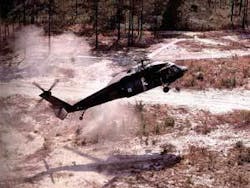DARPA launches Sandblaster helicopter avionics program
By John Keller
ARLINGTON, Va. - Scientists at the U.S. Defense Advanced Research Projects Agency (DARPA) in Arlington, Va., are launching a helicopter avionics program called Sandblaster to help pilots fly safely in zero-visibility conditions such as dust, fog, rain, and snow.
DARPA released a broad agency announcement (BAA) last month (BAA06-45) that asks the defense and aerospace industry for ideas on rapidly developing affordable sensor and visualization display systems to improve helicopter landing capability particularly in the world’s desert areas where choking dust clouds are common.
Sandblaster is a high-priority effort to develop and demonstrate ways for helicopters to land safely in brownout as well as other degraded visual environments (DVEs) where the visibility is temporarily as low as zero. DARPA officials are particularly interested in electronic and optoelectronic pilot aids to help during operations in unimproved landing zones where pilots have limited knowledge of the terrain.
In charge of the program are officials of the DARPA Strategic Technology Office (STO). The point of contact is Dr. Reggie Brothers, whose e-mail for the program is [email protected]. The program’s Web site is www.darpa.mil/ato/solicit/Sandblaster/index.htm.
The brownout phenomenon, which can cause deadly accidents during helicopter desert landings and takeoffs, happens when the helicopter’s main-rotor downwash stirs up intense, blinding dust clouds during flight near the ground. Brownout can cause helicopter pilots suddenly to lose all visual cues, which can lead to aircraft and ground obstacle collisions, rollover due to sloped and uneven terrain, and other catastrophes.
DARPA officials say Sandblaster must be self-contained, and include necessary sensors, instruments, and displays to provide landing guidance to the pilot. Equipment must be compatible with existing military helicopters like the UH-60 Black Hawk.
Sandblaster, at a minimum, must provide brownout landing capability in zero/zero-visibility conditions with warning of lateral, fore, and aft drift; ground obstacles; sloping/uneven terrain in the landing zone that could induce dynamic rollover; and of potential collisions with other nearby aircraft and buildings.
Landing guidance will come from conventional or modified instrumentation, new human-factored cognitive primary functional displays, or a combination of both.
The first systems developed specifically must be configurable to integrate with MH/UH-60 A/L/M-model Black Hawk helicopters. The system must be able to provide aircraft rate of descent; absolute height above the ground with accuracy goal of one foot when below 50 feet altitude; and drift velocity with accuracy goal of 1 knot and drift direction accuracy goal of 1 degree.
DARPA experts will assess Sandblaster system effectiveness in a government-specified flight simulator such as the NASA Ames Vertical Motion Simulator or the U.S. Army JUH-60A RASCAL test bed, where they will measure task performance time, sink rate at touchdown, lateral velocity at touchdown (ideally zero), forward velocity at touchdown (ideally minimal), and course/altitude profile deviation.
Novel approaches to using cognitive and physiological assessment of pilot workload may be included in the system evaluation to increase our understanding of pilot reactions to the landing environment, DARPA officials say.
More information about the Sandblaster program and DARPA’s industry solicitation is available online at www.fbodaily.com/archive/2006/09-September/08-Sep-2006/FBO-01135646.htm.

